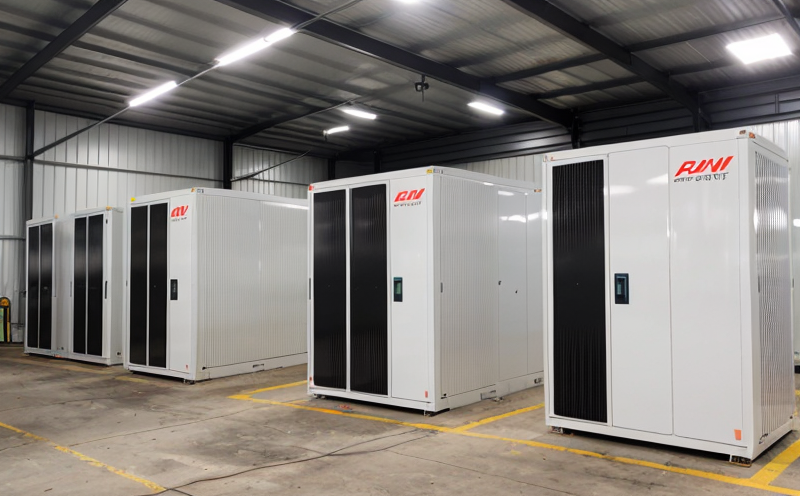ASTM D4728 Random Vibration Testing of Battery Transport Packaging
The ASTM D4728 standard provides a method for determining the performance of transport packaging used to protect batteries from damage during transportation. This testing is critical in ensuring that battery products meet safety and reliability standards, especially when they are transported internationally.
Random vibration testing simulates real-world conditions encountered by packages during shipping. By subjecting the packaging to random vibrations over a specified frequency range, this test evaluates how well the packaging can withstand these stresses without compromising the integrity of the contained battery or causing hazardous materials to leak.
The testing procedure outlined in ASTM D4728 is designed for laboratory use and covers the complete testing process from specimen preparation to data analysis. The standard specifies a range of frequencies, amplitude levels, and durations that simulate various modes of transportation such as air, sea, or road transport.
In practice, this test involves several key steps. First, the battery transport packaging is prepared according to the standard requirements, ensuring it meets the specified dimensions and weight limits. The package is then subjected to random vibrations using a shaker system capable of generating controlled frequency ranges and amplitudes.
Once testing begins, sensors placed within or attached to the package monitor its response to the applied vibrations. Data collected includes displacement, acceleration, and peak-to-peak values across multiple channels. This data is crucial for assessing whether the packaging has performed adequately under simulated transportation conditions.
The test concludes when all specified parameters have been met. At this point, the package’s structural integrity must be evaluated visually, as well as through any applicable non-destructive testing methods (NDT). If damage or leaks are detected during inspection, further investigation into design flaws may be necessary.
ASTM D4728 also emphasizes the importance of proper documentation throughout the entire testing process. Detailed records of test conditions, observed responses, and any corrective actions taken should be maintained for compliance purposes. Such documentation serves as critical evidence supporting product safety claims made by manufacturers.
This type of testing is particularly relevant given today’s increasing emphasis on sustainable energy solutions like electric vehicles (EVs) and renewable energy storage systems. Ensuring that batteries used in these applications are properly packaged to withstand rigorous transportation can extend their operational lifetimes, reduce waste associated with premature failures, and enhance overall environmental sustainability.
Compliance with ASTM D4728 is essential for companies involved in the manufacturing or distribution of lithium-ion batteries and other similar technologies. Failure to meet these standards could result not only in product recalls but also potential legal liabilities due to safety concerns arising from improper packaging practices.
Customer Impact and Satisfaction
Implementing ASTM D4728 random vibration testing benefits customers by enhancing the reliability and safety of battery transport packaging. For quality managers responsible for ensuring product integrity, this service provides peace of mind knowing that their suppliers adhere to industry best practices.
Compliance officers gain assurance that they are meeting regulatory requirements set forth by relevant bodies such as OSHA (Occupational Safety and Health Administration) or local transportation authorities. R&D engineers can rely on consistent test results when developing new designs, while procurement professionals benefit from knowing they are sourcing high-quality components.
Ultimately, satisfied customers appreciate products that arrive undamaged after transport. This satisfaction translates into increased customer loyalty and potentially higher sales volumes for businesses operating within the energy sector.
International Acceptance and Recognition
The ASTM D4728 standard enjoys widespread acceptance among manufacturers, distributors, and regulatory agencies worldwide. Many countries have incorporated its provisions into national standards or guidelines for battery transport packaging.
Recognizing the importance of consistent testing methods across borders, international organizations like ISO (International Organization for Standardization) have referenced ASTM D4728 in their own documents. This cross-referencing underscores the global relevance and reliability of this particular test method.
By adhering to ASTM D4728 guidelines during production processes, companies demonstrate a commitment to excellence that resonates positively with international partners and stakeholders alike. This alignment fosters trust between trading nations and promotes fair trade practices within the global market.
Environmental and Sustainability Contributions
The use of ASTM D4728 random vibration testing contributes significantly to environmental sustainability efforts in several ways. First, by preventing battery leaks during transportation, this practice helps avoid contamination of soil and water bodies.
Secondly, properly packaged batteries contribute to longer product lifecycles, reducing the need for frequent replacements and thus minimizing resource consumption. Additionally, since many materials used in packaging are recyclable, adopting robust testing procedures ensures that only high-quality components enter recycling streams.
Achieving compliance with ASTM D4728 also supports broader initiatives aimed at promoting circular economies by encouraging responsible waste management practices throughout the supply chain.





